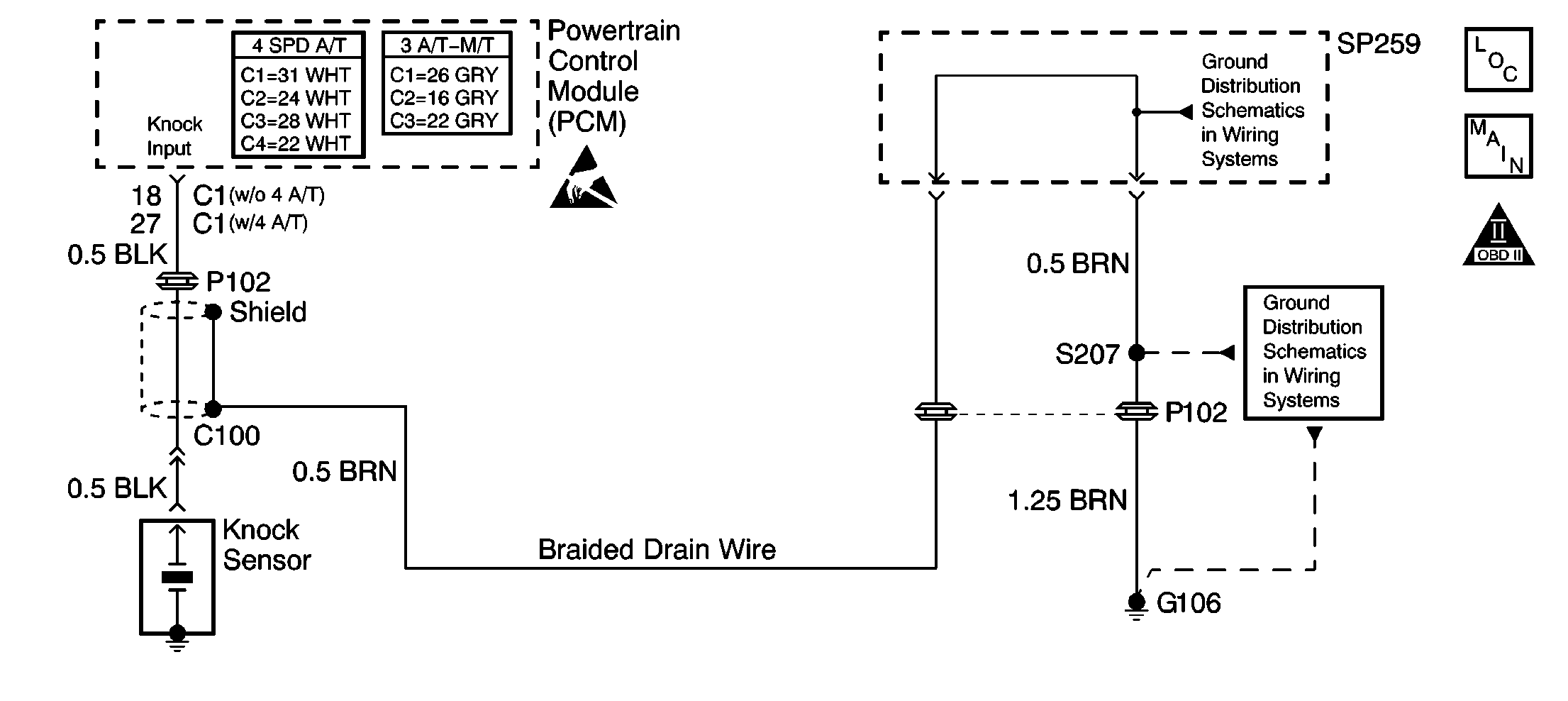
Circuit Description
The knock sensor (KS) is used to detect engine detonation. The KS is constructed of a piezoelectric element which generates an AC signal when vibrated. Normal engine operation will cause the KS to generate a signal of a certain known frequency. When engine knock is present, the KS frequency changes which signals the PCM to retard ignition timing. By retarding the ignition timing, the engine detonation detected should be reduced.
Conditions for Running the DTC
| • | The engine speed is 1,200 RPM or more. |
| • | The vehicle spped sensor (VSS) and the throttle position (TP) sensor indicate that the vehicle is accelerating. |
Conditions for Setting the DTC
The KS signal detected is below specifications for more than 20 seconds.
Action Taken When the DTC Sets
| • | The PCM illuminates the MIL. |
| • | The PCM stores the conditions which were present when the DTC set as Freeze Frame data. |
| • | The PCM enters the Fail-Safe function and defaults to maximum spark retard. |
Conditions for Clearing the MIL/DTC
| • | The PCM turns OFF the MIL on the third consecutive trip cycle during which the diagnostic has been run and the fault condition is no longer present. |
| • | The DTC clears after 40 consecutive warm-up cycles have occurred without a fault. |
| • | A DTC can be cleared by using the scan tool Clear DTC Information function. |
Diagnostic Aids
A loose KS can cause a loss of the KS signal. Check the KS for proper torque. The correct KS sensor torque is 39 N·m (29 lb ft).
An intermittent malfunction may be caused by a fault in the KS sensor electrical circuit. Inspect the wiring harness and the components for any of the following conditions:
| • | Any backed-out terminals |
| • | Any improper mating of terminals |
| • | Any broken electrical connector locks |
| • | Any improperly formed or damaged terminals |
| • | Any faulty terminal-to-wire connections |
| • | Any physical damage to the wiring harness |
| • | A broken wire inside the insulation |
| • | Any corrosion of the electrical connections, the splices, or the terminals |
Repair any electrical circuit faults that were found. Refer to Wiring Repairs in Wiring Systems.
The information included in the Freeze Frame data can be useful in determining the vehicle operating conditions present when the DTC first set.
Test Description
The numbers below refer to the step numbers in the diagnostic table.
-
The OBD System Check prompts the technician to complete some basic checks and store the Freeze Frame data on the scan tool if applicable. This creates an electronic copy of the data taken when the fault occurred. The information is then stored in the scan tool for later reference.
-
This step checks whether the DTC P0325 is the result of a hard failure or an intermittent condition. Operating the vehicle in Check mode enhances the diagnostic capabilities of the PCM.
-
This step checks the knock sensors ability to output the correct frequency signal for a given engine speed.
-
This step checks if the fault is the knock sensor input wiring.
Step | Action | Values | Yes | No |
|---|---|---|---|---|
Did you perform the Powertrain On-Board Diagnostic (OBD) System Check? | -- | |||
Does DTC P0325 set? | -- | Go to Diagnostic Aids | ||
Is the A/C frequency near the specified value? | 12.5 kHz | |||
Is the A/C frequency near the specified value? | 12.5 kHz | |||
5 |
Ensure that the terminal connection at the sensor is good. Is the action complete? | -- | -- | |
6 | Replace the knock sensor. Refer to Knock Sensor Replacement . Is the action complete? | -- | -- | |
7 | Replace the PCM. Refer to Powertrain Control Module Replacement . Is the action complete? | -- | -- | |
8 |
Are any DTCs displayed on the scan tool? | -- | System OK |
